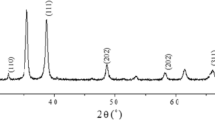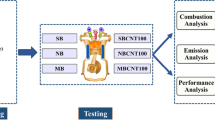Abstract
The need of alternate fuel for the reason is demand of fossil fuel and environmental degradation in all over the world. Biodiesel plays an important role because of its potential and availability in the environmental degradation and present energy crisis. The main objective of this experimental work is to reduce the emission without affecting the engine performance with alternate fuel. In this paper, the experimental analysis engine was run by B20EEGAO (20% ethyl ester of ground nut acid oil) with multi-walled carbon nanotubes (MWCNT) in the proportions of 10, 20, 30, 40 and 50 ppm. Five samples of MWCNT with B20EEGAO blend are prepared with the help of ultrasonicator. The important results smoke density of MWCNT30ppmB20EEGAO blend was 50 HSU at maximum load. The CO emission of MWCNT30ppmB20EEGAO blend is reduced in 20%, and HC emission is reduced for 15% compared to diesel. The observed results were that the brake thermal efficiency was higher in MWCNT30ppmB20EEGAO compared to biodiesel, and emission was also reduced except oxides of nitrogen. The best blend selected is MWCNT30ppmB20EEGAO compared to other blends.














Similar content being viewed by others
Abbreviations
- BTH:
-
Brake thermal efficiency
- CO:
-
Carbon monoxide
- EEGAO:
-
Ethyl ester of groundnut acid oil
- GC–MS:
-
Gas chromatography–mass spectrometry
- NOx:
-
Nitrogen of oxides
- SFC:
-
Specific fuel consumption
- MWCNT:
-
Multi-walled carbon nanotubes
- EGT:
-
Exhaust gas temperature
- HC:
-
Hydrocarbon
- FT-IR:
-
Fourier transform infrared spectroscopy
References
Rashedul, H.K.; et al.: Attempts to minimize nitrogen oxide emission from diesel engine by using antioxidant-treated diesel-biodiesel blend. Environ. Sci. Pollut. Res. 24(10), 9305–9313 (2017)
Deivajothi, P.; Manieniyan, V.; Sivaprakasam, S.: Experimental investigation on DI diesel engine with fatty acid oil from by-product of vegetable oil refinery. Ain Shams Eng. J. 10(1), 77–82 (2019)
Velumani, V.; Manieniyan, V.; Sivaprakasam, S.: Comparative vibration analysis on IC engine with biodiesel and multi-walled carbon nanotube. J. VibroEng. 21(7), 1810–1818 (2019)
Velumani, V.; Manieniyan, V.; Sivaprakasam, S.: Effect of multi-walled carbon nanotubes in di diesel engine. ARPN J. Eng. Appl. Sci. 14(7), 1396–1399 (2019)
Ettefaghi, E.; et al.: A novel bio-nano emulsion fuel based on biodegradable nanoparticles to improve diesel engines performance and reduce exhaust emissions. Renew. Energy 125, 64–72 (2018)
Manieniyan, V.; Vinodhini, G.; Senthilkumar, R.; Sivaprakasam, S.: Wear element analysis using neural networks of a DI diesel engine using biodiesel with exhaust gas recirculation. Energy 114, 603–612 (2016)
Sukumar, V.; Manieniyan, V.; Senthilkumar, R.; Sivaprakasam, S.: Production of bio oil from sweet lime empty fruit bunch by pyrolysis. Renew. Energy 146, 309–315 (2020)
Ramakrishnan, M.; Thansekhar, M.R.; Karthickeyan, V.: Comparative studies on the performance and emissions of a direct injection diesel engine fueled with neem oil and pumpkin seed oil biodiesel with and without fuel preheater. Environ. Sci. Pollut. Res. 25(5), 4621–4631 (2018)
Senthilkumar, R.; Manieniyan, V.; Sivaprakasam, S.: Engine Performance and emissions of DI diesel engine operating on biodiesel (Tessi Oil) with exhaust gas recirculation (EGR). Int. J. Adv. Eng. Res. Dev. 1(10), 46–51 (2014)
Senthilkumar, R.; Manieniyan, V.; Sivaprakasam, S.: Experimental investigation on DI diesel engine using bio additive. Int. J. Appl. Eng. Res. 10(8), 6210–6214 (2015)
Silambarasan, R.; Manieniyan, V.; Senthilkumar, R.; Sivaprakasam, S.: Performance and emission analysis in DI diesel engine using biodiesel with bio additive. Int. J. Eng. Trends Technol. 4(5), 865–868 (2017)
Srivastava, A.K.; Soni, S.L.; Sharma, D.; Sonar, D.; Jain, N.L.: Effect of compression ratio on performance, emission and combustion characteristics of diesel–acetylene-fuelled single-cylinder stationary CI engine. Clean Technol. Environ. Policy 19(5), 1361–1372 (2017)
Sasikumar, R.; Sankaranarayanan, G.: A study of emission and performance characteristics of diesel engine run by dual fuel (bio diesel + acetylene Gas). J. Mech. Eng. Res. Dev. 42(1), 104–108 (2019)
Husnawan, M.; et al.: Use of post flame metal-based and oxygenated additive combination for biodiesel-diesel blends. J. Sci. Ind. Res. 68(12), 1049–1052 (2009)
Manieniyan, V.; Sivaprakasam, S.: Experimental analysis of exhaust gas recirculation on DI diesel engine operating with biodiesel. Int. J. Eng. Technol. 3, 129–135 (2013)
Bhale, P.V.; Deshpande, N.V.; Thombre, S.B.: Improving the low temperature properties of biodiesel fuel. Renew. Energy 34(3), 794–800 (2009)
Yetter, Richard A.; Risha, Grant A.; Son, Steven F.: Metal particle combustion and nanotechnology. Proc. Combust. Inst. 32(2), 1819–1838 (2009)
Basha, J.S.; Anand, R.B.: Performance, emission and combustion characteristics of a diesel engine using carbon nanotubes blended jatropha methyl ester emulsions. Alex. Eng. J. 53(2), 259–273 (2014)
Saraee, H.S.; et al.: Reduction of emissions and fuel consumption in a compression ignition engine using nanoparticles. Int. J. Environ. Sci. Technol. 12(7), 2245–2252 (2015)
Prabu, S.S.; et al.: Effect of additives on performance, combustion and emission behavior of preheated palm oil/diesel blends in DI diesel engine. Renew. Energy 122, 196–205 (2018)
Abdalla, S.; Al-Wafi, R.; Pizzi, A.: Stability and combustion of metal nano-particles and their additive impact with diesel and biodiesel on engine efficiency: a comprehensive study. J. Renew. Sustain. Energy 9(2), 022701 (2017)
Deivajothi, P.; Manieniyan, V.; Sivaprakasam, S.: An impact of ethyl esters of groundnut acid oil (vegetable oil refinery waste) used as emerging fuel in DI diesel engine. Alex. Eng. J. 57(4), 2215–2223 (2017)
Jamrozik, A.; et al.: Effect of diesel/biodiesel/ethanol blend on combustion, performance and emissions characteristics on a direct injection diesel engine. Therm. Sci. 21(1B), 591–604 (2017)
Sivakumar, M.; Sundaram, N.S.; Thasthagir, M.H.: Effect of aluminium oxide nanoparticles blended pongamia methyl ester on performance, combustion and emission characteristics of diesel engine. Renew. Energy 116, 518–526 (2018)
Kumar, S.S.; Krishnan, P.; Kuppusamy, R.: Performance analysis of a biodiesel fuelled diesel engine with the effect of alumina coated piston. Therm. Sci. 21(1B), 489–498 (2017)
Manieniyan, V.; Sukumar, V.; Senthilkumar, R.; Sivaprakasam, S.: Emission reduction using biodiesel blends with nano-additives and reformed exhaust gas recirculation (REGR) in DI diesel engine. Int. J. Ambient Energy (2019). https://doi.org/10.1016/j.renene.2019.03.078
Gumus, S.; et al.: Aluminum oxide and copper oxide nanodiesel fuel properties and usage in a compression ignition engine. Fuel 163, 80–87 (2016)
Nikolic, B.D.; et al.: Effect of biodiesel on diesel engine emissions. Therm. Sci. 22, 1483–1498 (2018)
El-Seesy, A.I.; et al.: Performance, combustion, and emission characteristics of a diesel engine fueled by biodiesel–diesel mixtures with multi-walled carbon nanotubes additives. Energy Convers. Manag. 135, 373–393 (2017)
Prabu, A.; Anand, R.B.: Emission control strategy by adding alumina and cerium oxide nano particle in biodiesel. J. Energy Inst. 89(3), 366–372 (2016)
El-Seesy, A.I.; et al.: The influence of multi-walled carbon nanotubes additives into non-edible biodiesel-diesel fuel blend on diesel engine performance and emissions. Energy Proc. 100, 166–172 (2016)
Author information
Authors and Affiliations
Corresponding author
Rights and permissions
About this article
Cite this article
Manieniyan, V., Senthilkumar, R., Sukumar, V. et al. Analysis on DI Diesel Engine with Combined Multi-walled Carbon Nanotubes and Vegetable Oil Refinery Waste as Biodiesel. Arab J Sci Eng 45, 9197–9211 (2020). https://doi.org/10.1007/s13369-020-04708-y
Received:
Accepted:
Published:
Issue Date:
DOI: https://doi.org/10.1007/s13369-020-04708-y




